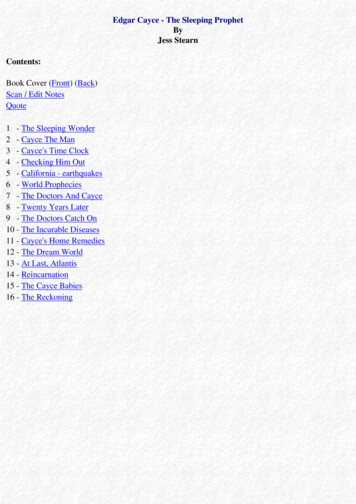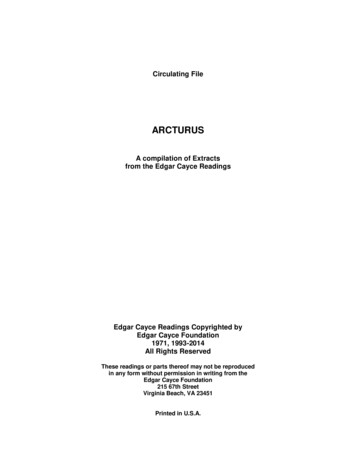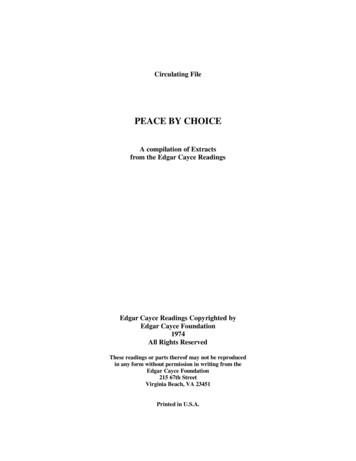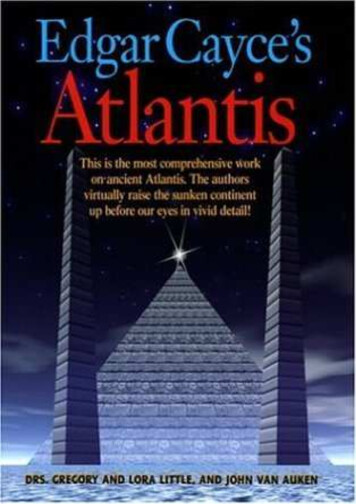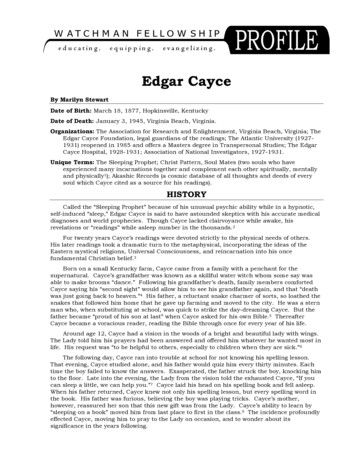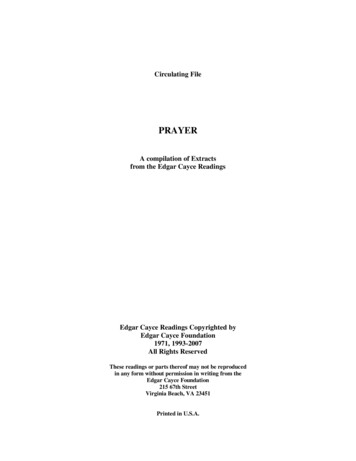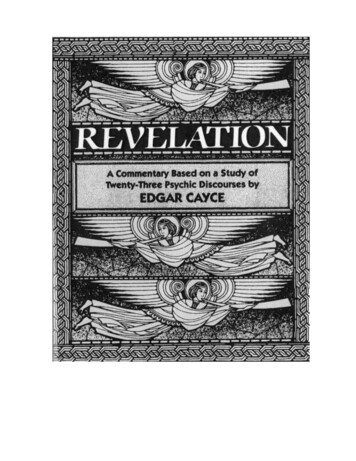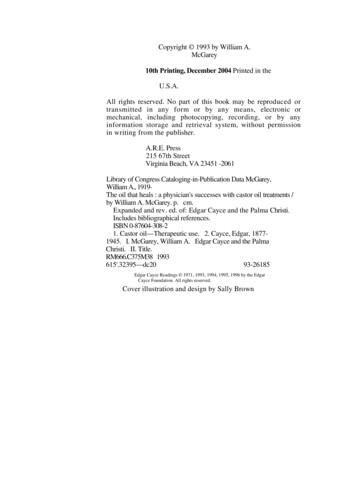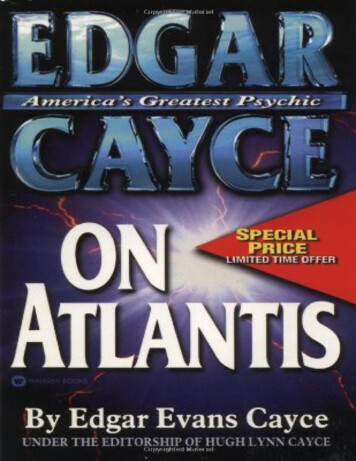
Transcription
EDGAR CAYCEonATLANTISby Edgar Evans Cayceunder the editorship of Hugh Lynn CayceDirector, Association for Research and EnlightenmentHAWTHORN BOOKS, INC. NEW YORKW. CLEMENT STONE, PUBLISHER
EDGAR CAYCE ON ATLANTISCopyright 1968 by the Association for Research and Enlightenment, Inc. Copyright underInternational and Pan-American Copyright Conventions. All rights reserved, including the right toreproduce this book, or portions thereof, in any form, except for the inclusion of brief quotations in areview. All inquiries should be addressed to Hawthorn Books, Inc., 70 Fifth Avenue, New York City10011. This book was manufactured in the United States of America and published simultaneously inCanada by Prentice-Hall of Canada, Ltd., 1870 Birchmount Road, Scarborough, Ontario. It was firstpublished in 1968 by Paperback Library, Inc., New York City. Library of Congress Catalogue CardNumber: 68-19109.First Hardbound Edition: 1968Second Printing: 19681035TOMy Wife and Childrenwhose patience and cooperation helped a great dealin the preparation of this book
CONTENTSPreface by Hugh Lynn Cayce 9Introduction 15Chapter 1: The Legend of Atlantis 17Chapter 2: Life Readings and Reincarnation 30Chapter 3: Atlantis Before 50,000 B. C. 48Chapter 4: 50,000 B. C. to 10,000 B. C. 84Chapter 5: The Final Destruction 108Chapter 6: The Shadow of Atlantis 156References 165The A. R. E. Today 169
PREFACEWho was Edgar Cayce?The six books which have been written about him have totaled more than amillion in sales, and more than ten other books have devoted sections to hislife and talents. He has been featured in dozens of magazines and hundredsof newspaper articles dating from 1900 to the present. What was so uniqueabout him?It depends upon your point of view. A number of his contemporariesknew the "waking" Edgar Cayce as a gifted professional photographer.Another group (Predominantly children) admired him as a warm andfriendly Sunday School teacher. His own family knew him as a wonderfulhusband and father.The "sleeping" Edgar Cayce was an entirely different figure, a psychicknown to thousands of people in all walks of life. Many had cause to begrateful for his help; indeed, some of them believe that he alone eithersaved or changed their lives when all seemed lost. The "sleeping" EdgarCayce was a medical diagnostician, a prophet, and a devoted proponent ofBible lore.In June 1954, the University of Chicago held him in sufficient esteem toaccept a Ph.D. thesis based on a study of his life and work: in this thesis theauthor referred to him as a "religious seer." That same June, the children'scomic book House of Mystery bestowed on him the impressive title of"America's Most Mysterious Man!"
Even as a child on a farm near Hopkinsville, Kentucky, where he wasborn on March 18, 1877, Edgar Cayce displayed powers of perceptionwhich seemed to extend beyond the normal range of the five senses.9At the age of six or seven he told his parents that he was able to see and talkto "visions," sometimes of relatives who had recently died. His parentsattributed this to the overactive imagination of a lonely child who had beeninfluenced by the dramatic language of the revival meetings which werepopular in that section of the country. Later, by sleeping with his head onhis schoolbooks, he developed a form of photographic memory whichhelped him advance rapidly in the country school. This faded, however, andEdgar was only able to complete the seventh grade before he had to seek hisown place in the world.In 1898 at the age of twenty-one he became a- salesman for a wholesalestationery company. About this time he developed a gradual paralysis of thethroat muscles which threatened the loss of his voice. When the doctorswere unable to find a physical cause for these conditions, hypnosis wastried, but failed to have any permanent effect.As a last resort, Edgar asked a friend to help him reenter the same kind ofhypnotic sleep that had enabled him to memorize his schoolbooks as achild. His friend gave him the necessary suggestion, and once he was inself-induced trance, Edgar came to grips with his own problem. Herecommended medication and manipulative therapy which successfullyrestored his voice and cured his throat trouble.A group of physicians from Hopkinsville and Bowling Green, Kentucky,took advantage of his unique talent to diagnose their own patients. Theysoon discovered that Cayce only needed to be given the name and address
of the patient, and was then able to "tune in" telepathically on thatindividual's mind and body, wherever he was, as easily as if they were bothin the same room. He needed, and was given, no other informationregarding any patient.One of the young M.D.'s, Dr. Wesley Ketchum, submitted a report on thisunorthodox procedure to a clinical research society in Boston. On the ninthof October, 1910, The New York Times carried two pages of headlines andpictures. From that day on, invalids from all over the country sought helpfrom the "wonder man."When Edgar Cayce died on January 3, 1945, in Virginia Beach, Virginia,he left well over fourteen thousand documented stenographic records of thetelepathic-clairvoyant statements he had given for more than eightthousand different people over a period of forty-three years. Thesetypewritten documents are referred to as "readings."These readings constitute one of the largest and most impressive recordsof psychic perception ever to emanate from a single individual. Togetherwith their relevant records, correspondence, and reports, they have beencross-indexed under thousands of subject-headings and placed at thedisposal of the psychologists, students, writers and investigators who comein increasing numbers to examine them.An approximate breakdown of the readings according to subject matterindicate that about sixty percent are physical diagnoses, twenty percent are"life readings," and the remaining twenty- percent may be grouped underthe heading "other." The "other" category includes readings on businesstopics, mental and spiritual themes, dream interpretation and a variety ofmiscellaneous subjects.
A foundation known as the Edgar Cayce Foundation, located at 67th andAtlantic Avenue, Virginia Beach, Virginia, was founded to preserve thesereadings. An open-membership research society, the Association forResearch and Enlightenment, Inc. (abbreviated A.R.E.) P.O. Box 595,Virginia Beach, Virginia 23451, was organized in 1932 and it continues toindex and catalogue the information, initiate investigation and experiments,and promote conferences, seminars and lectures dealing with thesereadings and related material.Until recently the published findings of the A.R.E. have been availableprimarily to its members through its own publishing facilities. Now a seriesof books dealing with subjects of popular interest from the Edgar Caycereadings are available through Paperback Library, Inc., and HawthornBooks.This volume deals with a portion of the Edgar Cayce readings cataloguedas "life readings," particularly with those mentioning incarnations inAtlantis. These readings and the records surrounding them are some of themost controversial given during Cayce's remarkable life.The life readings describing past lives in Atlantis as if they wereexperiences in early England or early America cover a period of twentyyears between 1924 and 1944. They are the most fantastic, the most bizarre,the most impossible information in the Edgar Cayce files. It would be easyto present a very tight evidential picture of Edgar Cayce's psychic abilityand the helpfulness of his readings if we selected only those which areconfirmed and completely validated. This would not be fair in a total,overall evaluation of his life's work. My brother, the author, and I know thatEdgar Cayce did not read Plato's material on Atlantis, or books on Atlantis,and that he, so far as we know, had absolutely no knowledge of this subject.If his unconscious fabricated this material or wove it together from existinglegends and writings, we believe that it is the most amazing example of a
telepathic-clairvoyant scanning of existing legends and stories in print or ofthe minds of persons dealing with the Atlantis theory. As my brother and Ihave said from time to time, life would be simpler if Edgar Cayce had nevermentioned Atlantis. So, before others can point to these readings asunbelievable and impossible, here is the whole story. As the author haspointed out, there is a strange consistency within the hundreds of psychicreadings given over a period of twenty years. They will take you back intoprerecorded history to lands of myth and legend, and forward into a futureof literally earth-shaking changes. Whether you are a science-fiction fan,someone interested in the psychic or simply one who enjoys a good story,you will find in the following pages a totally new account of man on earthand a new concept of his relationship to God and his fellow men.I must warn you, though, that if you persist in reading this book you maynever be able to return to our so-called "real world of facts" without thenagging suspicion that the fantastic events depicted just might be taintedwith truth. Your suspicion may grow into something resembling convictionif Edgar Cayce's predictions for the next few years come to pass.Names used in stories are fictitious, although the stories are based onactual cases. The number following a quoted or paraphrased extractidentifies the reading from which it was taken, so that anyone so inclinedmay check the Edgar Cayce records at Virginia Beach for verification andfurther details.Hugh Lynn CayceINTRODUCTION
Should an engineer jeopardize his professional reputation, invite hisfriends' scorn and risk public ridicule by writing a book supporting thelegend of Atlantis? The answer is probably No, unless he happened tohave been on speaking terms with Edgar Cayce and familiar with hiswork, particularly his life readings. I was on speaking terms with EdgarCayce from my birth in 1918 until his death in 1945. He was my father.Furthermore, I have spent a great deal of time studying the records he left,especially the set of life readings concerning Atlantis.First I should like to summarize the legend of Atlantis, and introduce thereader to the Edgar Cayce life readings and the theory of reincarnation.Only then will be possible to understand the fantastic ideas and eventsdepicted in the amazing Atlantis documents. The information from thesereadings has been arranged to the best of my ability in chronological order.Books, encyclopedias and newspapers have been scanned for discoveriesthat seem to confirm statements made by Edgar Cayce. Finally, the readeris presented with a summary of the information, together with my opinionof its importance to him in particular and to America in general. There aregood—perhaps imperative—reasons why these data should be seriouslyconsidered.Let us turn now to the legend of Atlantis, and the arguments for andagainst its Existence.15
CHAPTER 1The Legend of Atlantis"Atlantis Believed Discovered But in Aegean Not Atlantic." So said aheadline in the Norfolk Ledger-Star, July 19, 1967.The same story appeared on the same date in the New York Times underthe headline: "Minoan City, Found After 3400 Years, Is Linked toAtlantis."Both stories refer to the discovery of a Minoan city, buried under thirtyfeet of volcanic ash, on the island of Thera in the Aegean Sea. In charge ofthe excavations were Dr. James W. Mavor of the Woods HoleOceanographic Institute and Mrs. Emily Vermeule, Professor of Art andGreek at Wellesley College. Mavor and Mrs. Vermeule link their discoverywith Atlantis because there is evidence that it was an advanced civilizationand because it came to a sudden violent end.Notice both headlines. The news value of this story is not so much thediscovery, practically intact, of a city that flourished about 1500 B.C., butits possible connection with fabled Atlantis. This is the most recent attemptto rationalize the Atlantis legend by changing its location and date.The oldest known mention of Atlantis is found in two of Plato's dialogues,"Timaeus" and "Critias," which date in the fifth century B.C. Platointroduces Atlantis in a conversation between Solon and certain Egyptian
priests at Sais, as a large island in the Atlantic which sank in a volcaniccatastrophe some nine thousand years previously.17Since Plato's time there have been hundreds of books and articles writtenabout Atlantis, most of these in the last two hundred years. Some try toshow that Plato's story of Atlantis was not only possible but probable.Others try to prove Atlantis a myth, or else rationalize the story byassociating Atlantis with some locality other than the mid-Atlantic andchanging the date to a more recent figure.A large portion of the Atlantis literature resides in the voluminous worksof occultists of one variety or another and the unorganized products ofeccentrics. It is the attention given to the Atlantis legend bypseudoscientists and cultists that causes legitimate scientists to avoid evendiscussing the subject.Several medieval writers refer to this legendary land, but probably thebest known and most popular book on Atlantis is Ignatius Donnelly'sAtlantis, the Antediluvian World. First published in 1882, it was revised andedited by Egerton Sykes in 1949. No book published before or since hasaccumulated such a mass of geological, archeological and legendarymaterial, nor presented so many ingenious and eloquent arguments insupport of the legend of Atlantis.Donnelly's arguments are based largely on evidence of similaritiesbetween the culture of ancient Egypt, and the Indian cultures of Central andSouth America. On both sides of the Atlantic one finds the use of a 365-daycalendar, the practice of embalming, the building of pyramids, legends of aflood, etc. Donnelly argues that both the ancient Egyptian and AmericanIndian cultures originated in Atlantis, and spread east and west when
Atlantis was destroyed. An Atlantean heritage, Donnelly suggests, wouldexplain the fact that the Basques of the Spanish Pyrenees differ from alltheir neighbors in appearance and language. ("The Basque tongue is theonly non-Aryan tongue of Western Europe"—Lincoln Library vol. I, p.516). Similarly the Canary Islanders bear little resemblance to any Africangroup and practiced mummification of their dead. Donnelly says Spain,Portugal and the Canary Islands would be likely landing spots for refugeesfrom sinking Atlantis. He compares the names of cities of Asia Minor andthose of Central America, cities which were already named when the firstEuropean explorers arrived.ASIA MINOR CENTRAL AMERICAChol Chol-ulaColua Colua-canZuivana ZuivanCholina ColinaZalissa XaliscoSuch similarities Donnelly says, are too much to ascribe to coincidence.Altogether Donnelly lists 626 reference sources. In spite of the flawscritics have found in his reasoning—he is accused of "reasoning from amolecule of fact to a mountain of surmise"—his was a monumental effort.His arguments make interesting reading even today and a worthwhile
project might be undertaken, using modern techniques, to sift facts fromspeculations in his intriguing book.Egerton Sykes, an Atlantean scholar who probably has the world's largestcollection of literature concerning Atlantis, says there are actuallythousands of books and articles on the subject dating from Plato to modemtimes. However, few writers have much to add to Donnelly's arguments. Anarticle supporting the possibility of Atlantis appeared in the November,1948 issue of Science Digest. This article, originally published in theTechnical Engineering News of the Massachusetts Institute of Technologyin June, 1948, reviews the best of Donnelly's arguments for the likelihoodof a sunken island continent. It discusses the existence of terrain features onthe ocean floor approximating those on land: i.e. mountains, valleys, plainswith trenches and holes resembling rivers and lakes. Of interest is the factthat only a relatively small warping of the earth's crust (1/8000th of itsdiameter) could cause considerable portions of the ocean floor to rise abovewater and other land features to subside. Possible evidence that this hasoccurred in the past is detailed in this article. In 1898 the crew of a shipemployed in laying submarine cable near the Azores was trying to locatewith grappling hooks a cable they had lost in water about two miles deep.The jagged, rocky nature of the ocean bottom there presented difficultiesand the grappling instruments had to be frequently cleaned of bits of matter.Here I quote from the article: "These particles of matter were found, onmicroscopic examination, to be lava, lava which must have solidified in theopen atmosphere because of its vitreous structure. (Lava which solidifiesunder water assumes a crystalline structure.) Since lava decomposesconsiderably in 15,000 years the area below must have been above thewater within that period." There is other more recent evidence for theformer existence of land in the Atlantic. An article by R.W. Kolbe in 1957(Science, vol. 126, pp. 1053-1056) reports the investigation of a deep-seacore taken from a depth of two miles on part of the Mid-Atlantic SubmarineRidge. His find of exclusively freshwater plants (diatoms) in portions of the
sedimentary materials offers evidence that this portion of the ridge wasonce above sea level.O. Mellis, in 1958, in a study of the genesis of the deep-sea sands in theAtlantic Ocean, indicates that the sands of the Romanche Deep probablyoriginated from weathering of parts of the Mid-Atlantic Ridge that onceprojected above the sea's surface.And in a 1959 Military Engineer report, we find that "duringhydrographic surveys by the U.S. Coast and Geodetic Survey sinkholes aslarge as 1/2 mile in diameter and 500 feet deep were discovered in thestraits of Florida 14 miles offshore from the Florida Keys, where the oceanis 900 feet deep. They are presumed to have been freshwater lakes in anarea which subsided."One of the best technical arguments for the existence of Atlantis is to befound in "Ocean Bottom Investigations and Their Bearings on Geology" byRene Malaise. This article appeared in Geologiska Foreningens I StockholmForhandlingar (Mars-April, 1957). Malaise argues that many of the terrainfeatures of the Mid-Atlantic Ridge area, particularly the canyons on theocean floor, could not have been cut by undersea turbidity currents but musthave been formed when the present sea floor was once above the surface.He discusses ocean currents and their effect on the ice that once coveredEurope and America ten to twelve thousand years ago. His article alsocontains drawings comparing flint points found in Sandia Cave, NewMexico, with Solutrean points from Morocco and France. The similarity ofthese flint points indicates a common origin. Since they are estimated to betwenty-five thousand years old, Malaise thinks their users may have spreadeast and west from Atlantis.Still, none of these observations prove that Atlantis existed. At best theyoffer evidence that large portions of the bottom of the Atlantic were above
the surface in the not-too-distant pas.From time to time a newspaper or magazine will carry an article or astatement quoting some authority as for or against the Atlantis legend. Forexample, the San lose Mercury of July 17, 1958, quoted a Soviet physicistand mathematician, Professor N. Ledner, as saying he had spent twentyyears studying the legends of Atlantis and was convinced that ancienthistorical documents and cultural monuments, together with recentscientific discoveries, show that such an island continent truly existed.Yet, in spite of the efforts of writers such as Donnelly, Malaise and othersto amass and connect archeological, geological and legendary material insupport of the Atlantis legend, there is no scientific proof of the existence ofAtlantis. Recognized remains of its culture and inhabitants are lacking.Myths and legends from the past, together with Plato's story, do survive toremind mankind of a bygone era. Some credible evidence is available tooffer the ossibility that "it might have been," but no evidence has beenuncovered to prove beyond doubt that "it was." This does not mean thatsuch evidence will never be discovered. But until it is, Atlantis is likely toremain a myth in scientific circles.What of the other side of the coin? Is there scientific proof that Atlantisnever existed? Actually, the greatest argument against the existence ofAtlantis is the lack of any explicit proof for its existence. Most geologistsconcur with the concept of uniformitarianism, which implies relativelygradual change. They do not believe that any catastrophic events, such aswould cause the sinking of a continent, have occurred in the recent past—the last ten to twenty thousand years. Some evidence is accumulating fordefinite, possibly drastic, climatic changes eleven to thirteen thousand yearsago, but authorities are not in agreement concerning possible accompanyingearth changes. The uniformitarian attitude is aptly expressed by ElizabethChesley Baity in her very readable book, America Before Man. Referring to
the legend of Atlantis, she says, "It is not surprising that very littlesatisfactory evidence has been found, since Atlantis—if it ever existed at all—disappeared long before the memory of mankind, and at the rate normalmovements of land take place it would have required millions of years forso large an island to subside into the depths of the sea."You have only to read the chapter on Atlantis and Lemuria in MartinGardner's book, In the Name of Science (paperback edition retitled Fadsand Fallacies) to see why most scientists shy away from the subject. Thischapter is full of shrewd, sarcastic comments on the theory of Atlantis andthose who have written about it. Gardner's main arguments against theexistence of Atlantis boil down to the fact that no reliable evidence,geological or archeological, supports it.Other writers have attacked the Atlantis story from different angles. E.Bjorkman in his Search for Atlantis drew upon material from the Bible, theOdyssey and the ritings of Herodotus, a Greek historian, in an effort to linkAtlantis to an ancient Spanish or Portuguese city.In Lands Beyond, L. Sprague de Camp and Willy Ley attack Plato'scredibility through his contemporaries but fail to reach positive conclusionsand end a chapter with this statement: "Just what Plato had in mind whenhe spoke of the Atlantic Ocean and the continent beyond is not quite clearto this day."Even scientists in widely separated fields have felt compelled to makestatements relegating Atlantis to the myth category.The 1936 Spring issue of The American Scholar carried an article by E.D.Merri(administrator of Botanical Collections, Harvard University) entitled"Scuttling Atlantis and Mu," in which he attempts by scientific argument todeny the possibility of Atlantis. He tries to show that there is no
philological relationship between American and Mediterranean languagesand no common domestic plants and animals in Mexico and theMediterranean. His theme is that the development of agriculture inAmerica paralleled that of the Old World but with a different series ofplants. He says that most cereals, along with temperate zone vegetables andfruits, are of Eurasian origin, while most American species are of tropicalor semi-tropical origin. He presents an impressive list of fruits andvegetables of the Old and New Worlds respectively. He argues that manentered America from Asia and that the high civilizations of Central andSouth America were developed without the influence of Atlantis andwithout intercourse with Europe and Asia. Merrill that not a singlecommon cultivated food plant or domesticated animal except the dogappeared in both hemispheres until after 1492.This view, however, of non-communication between Europe and Americaprior to Columbus is not shared by all scientists.T.S. Ferguson, archeologist and author, in his book One Fold and OneShepherd, presents an imposing array of facts to show similarities betweenthe culture of the Middle East and that of Central America. Theillustrations comparing seals, pottery designs, and architecture areconvincing. In addition he lists 298 items of common culture. Admittedly,ideas and designs of a similar or even identical nature may originate quiteindependently in different parts of the world, but as one reads Ferguson'slist of the number of different items and practices common to both the Oldand the New Worlds, the possibility that all of these originatedindependently in both hemispheres seems rather remote.Pages 22 and 23 of Ferguson's book contain an illustration of a seal dugup at Chiapa de Corzo in Mexico. Ferguson then quotes from a letter of Dr.Albright of Johns Hopkins the statement that "the seal contains severalclearly recognizable Egyptian hieroglyphs."
On pages 49 to 52 Ferguson quotes Dr. George F. Carter, also of JohnsHopkins, as saying, "Some plants positively were pre-Columbian in the OldWorld and the New World. There is a formidable list of plants, most ofthem related to the Middle-American, Southeast-Asian areas that range allthe way from probable to possible cultural transfers. The long-held doctrineof the absolute separation of Old and New World agriculture is no longertenable—the plant evidence should be re-examined without bias."Such statements, while they do not prove that Atlantis existed, indicatethat there are certainly questions in the minds of scientists as to the origin ofthe high civilizations in South and Central America, and disagreements overthe question of early plant domestication. The contemporary view issummarized in a beautifully illustrated book, Ancient Arts of the Andes byW.C. Bennett, sponsored by the Museum of Modem Art, New York, theMinneapolis Institute of Arts, and the California Palace of the Legion ofHonor. Bennett makes this comment: "The problem of the migration of theearliest inhabitants of South America is a fascinating and puzzling one, buthardly more so than that of the origin of the high civilization of the Andes.This involves the question of plant domestication and as yet the centerswhere the New World plants were first domesticated is far fromestablished."In the April 1949 issue of Science Digest another scientist in a differentfield, Dr. Maurice Ewing of Columbia University, has a short article entitled"Lost Continent Called Myth." Dr. Ewing is quoted as saying he has"mapped, probed, sounded and visited the ocean depths since 1935." Hetook undersea photographs as deep as 18,000 feet and "found no evidenceof buried cities." His search was concentrated along the Atlantic Ridgerunning from Iceland to Antarctica. At first glance this might be taken asproof against Atlantis' ever having existed, but a moment's reflection showsotherwise. Suppose the United States were wracked with earthquakes andvolcanic action for a few months—or years. Our cities collapse in rubble,
and are then buried under layers of ash and lava. Immense tidal wavessweep over the land, scattering and destroying any remaining structures andall evidence of man's handiwork. Finally the whole land settles under theocean, and for thirteen thousand years tidal currents scatter and oceansediment covers any residue of our civilization. In the year 14,967 someonetakes a picture of a few square feet of the ocean bottom, or drills a four-inchhole in the sea floor. Do you think he will see any cities or core into anautomobile, airplane or power plant? The chances are against it. But hewould doubtless feel justified in concluding that America never existed.The October 1953 issue of the Atlantic Monthly carried an article byRobert Graves called "What Happened to Atlantis?" Graves turns hisattention to Greek myths and tries to show that the myth of Atlantis arosefrom the confusion of a Libyan disaster with the glory and demise of thecivilization of Crete. He says that the Cretans converted a small island,Pharos, near the mouth of the Nile into a port which was one of the wondersof the world. The spectacular sinking of this island shortly after theestruction of Cnossus (a principal city of the Minoan in Crete) was united inlegend with the traditions of a flood that caused the destruction of theLibyan people in Lake Tritons (at one time a huge inland sea which todayhas shrunk to the Mareth salt marshes). These stories were handed down bythe priests of Sais to Solon who embroidered the legends, thus creating ouridea of Atlantis. However, the dates of the disasters cited by Graves are somuch more recent than the date ascribed by Plato to the Atlantis cataclysmthat one finally feels Graves' article, interesting though it is, is as full ofspeculation as any of Donnelly's arguments.One of the most recent arguments against the possibility of a midAtlantic continent appeared in the October 21, 1961 issue of the SaturdayEvening Post. In an article called, "The Spreading Ocean Floor," Dr. RobertS. Dietz advances a theory concerning the composition of the earth's crustand of a spreading ocean floor which he says would seem to preclude the
existence of Atlantis. If as he says, however, the continents are onlymoving apart an inch or so a year, there would have been little change inthe last ten to fifteen thousand years. Dr. Dietz is a respectedoceanographer, but his theory may be only partially true. At any rate,allowing for drastic earth changes, there is sufficient time in the time scaleof earth's history to slip in a continent or two in the oceans.Finally, we seem to be going around in circles. The harder one tries tosolve the problem of Atlantis the clearer it seems to become that nosolution is possible. There is no convincing proof one way or the other incurrent literature. Until some written records of its history, other thanPlato's, are
I was on speaking terms with Edgar Cayce from my birth in 1918 until his death in 1945. He was my father. Furthermore, I have spent a great deal of time studying the records he left, especially the set of life readings concerning Atlantis. First I should like to summarize the legend of Atlantis, and introduce the reader to the Edgar Cayce life .
